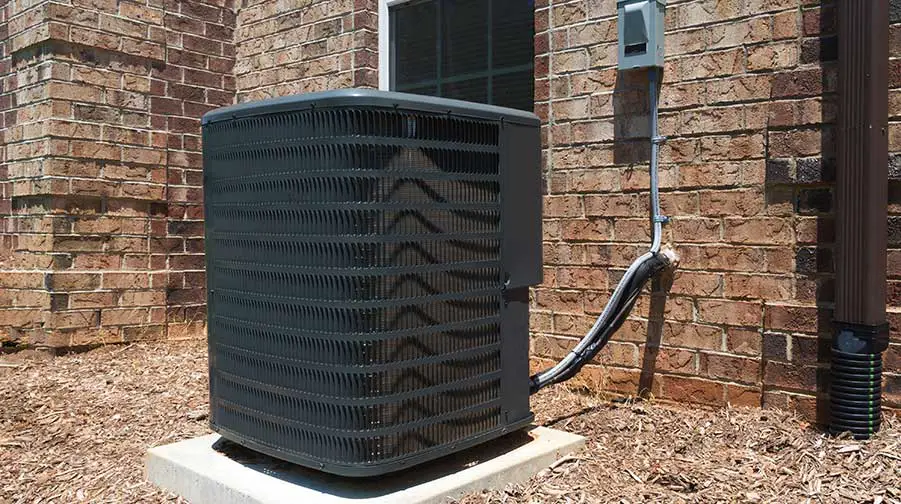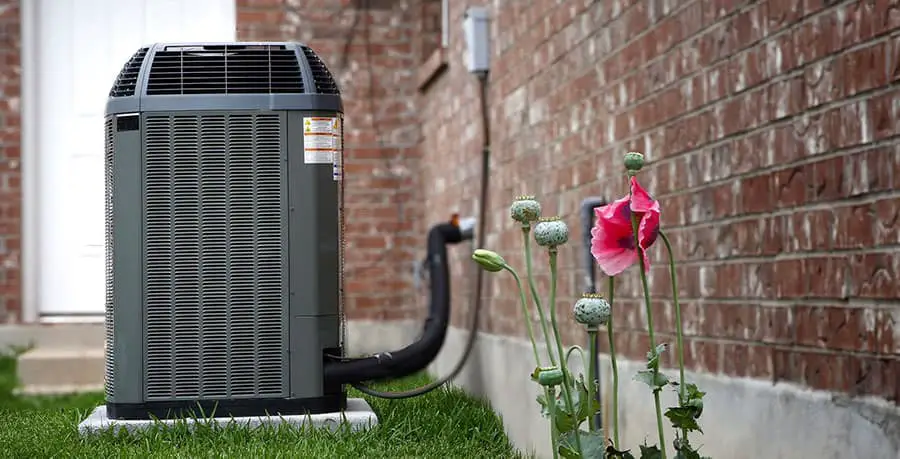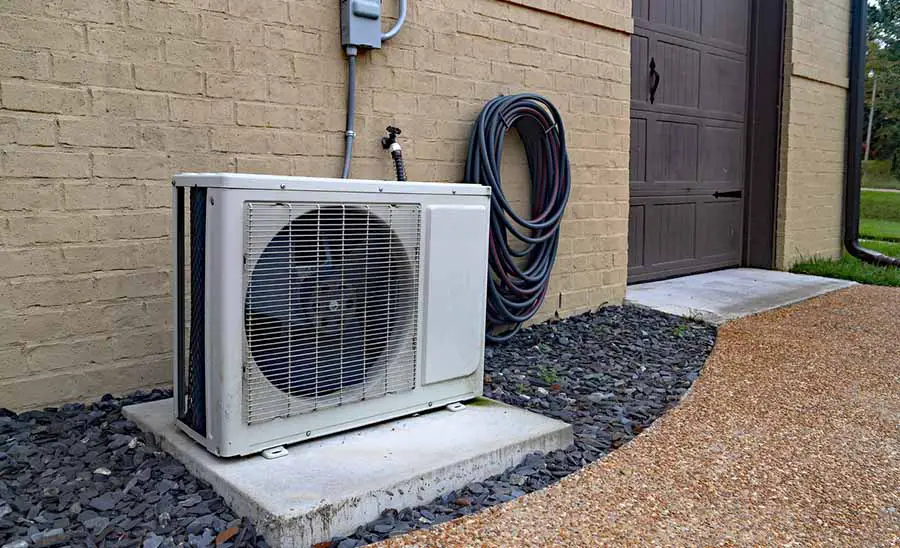
A heat pump offers you a convenient way to heat or cool your home while spending less on energy. However, the placement of a heat pump condensing unit can sometimes be tricky.
When installing a heat pump, you need a clearance of an average of 12 to 24 inches (one to two feet) in all directions, but you can place it as far away as 100 feet from the house. Several things should influence the final position of a heat pump from a home. Below are some of them:
- Manufacturer’s instructions
- Local building codes
- Drainage
- The elements
- Airflow requirements
- Debris in the vicinity
- Ease of access
- Security
- Aesthetics
- Environmental concerns
- Type of heat pump
Most split heat pumps I see installed are about 24 inches from the exterior walls of a house. However, I have witnessed instances where the condensing units were placed as far as 50 feet from the house, mostly for aesthetic purposes.
This article discusses the basics of how a heat pump works. In addition, it provides clearance tips based on factors affecting where you finally install the equipment.
11 Tips on How Far Should a Heat Pump Be From Your House
Understanding the many factors that affect the heat pump’s position from your home helps you choose the best location for your heat pump. Below are clearance tips worth considering:

1. Read the Manufacturer’s Instructions
Warranties tend to cover parts, and sometimes, labor costs for a specified period. During that time, if something happens to your heat pump, you would not have to worry about paying for some or all the costs of fixing them. To have the best chance of enjoying such a warranty, it would be best to install the heat pump according to the manufacturer’s instructions.
Some manufacturers, such as Lenox, LG, Daikin, Trane, and Amana, usually offer heat pump warranties ranging from five years to more than ten. Other similar products may be covered under a home warranty.
Therefore, if the brand you buy has instructions to install a heat pump a specified distance from your house and so many inches high from the ground, you need to do just that. Otherwise, you risk voiding the warranty, which would leave you liable for any costs that arise during the warranty period if the heat pump experiences damage.
2. Follow Your Local Building Codes
While some general codes guide the construction and installation of electrical devices, others vary from one state or locale to another. For that reason, you should pay very close attention to what your local building codes say about installing heat pumps.
Typically, you don’t need permits if you intend to replace one heat pump with a different one. However, you will likely need a permit to replace a heating system, such as a gas furnace, with a heat pump.
That said, some state by-laws require permits for any heat pump installations regardless of the circumstances. For example, in Seattle, you need a refrigeration permit to install a heat pump within your property.
When local building codes set the rules and possibly require permits, you are bound by them when finding the right installation position.
3. Consider the Drainage of the Area
Common sense dictates that you keep electrical components free from wet conditions, such as floods, even when they are meant to be somewhat weatherproof. They tend to malfunction when exposed to water. And you would need to invest time, money, and energy in fixing or replacing these parts to make them work again.
Therefore, drainage is a much bigger issue than you may realize because it affects the water flow from rain, sleet, and snow. And that, in turn, affects where you can place your heat pump.
Also, your soil’s ability to drain water can affect its saturation levels, which would also affect the rate of heat transfer by ground-source heat pumps. At the same time, if water is used for heat transfer, soils that promote groundwater accumulation may be highly suitable for the associated heat pumps.
4. Protect Your Heat Pump from the Elements
One section of the heat pump will always be on the outside. For that reason, the elements and your heat pump’s exposure to them affects where you can position it. Heat pumps tend to be weatherproof. However, they still need protection from direct sunlight, excessive snow, and rain.
For starters, excessive sunlight may cause some heat pump parts to degrade faster.
Also, providing a large shade area may help improve air conditioning systems’ efficiency by about 10 percent. That’s because direct sunlight increases the starting temperatures and forces the pump to work harder to cool a space, which, in turn, consumes more electricity.
As we have previously established, water may be suitable for ground-source pumps that use the medium for heat transfer. However, when the electrical components are exposed to excess moisture, they may not work.
On the other hand, excessive snow or ice may block airflow, which a heat pump requires to function optimally. As a result, it will be less energy-efficient and cost you more to run it.
5. Observe Air Flow Requirements
Proper airflow is one of the most critical requirements for heat pumps, especially air-source versions. Pulling heat from air necessitates the availability of air around the electrical device. So, open space is necessary for excellent ventilation.
The minimum 24 inch-clearance requirement on all sides is to enable your pump to have free-flowing air around it. Without it, your pump will operate at higher temperatures than normal, which would cause its parts to experience wear and tear faster. Also, poor ventilation can decrease energy efficiency and increase energy costs.
Some of the obstacles you should keep far away from a heat pump include walls, vegetation, and fencing. But it would help if you also observed the required distances from other similar units, different appliances, openings, and the top.
For example, if you have a mechanical system, such as a gas vent, it should be four to eight feet away from the heat pump. And if you have another outdoor heat pump unit, you must place the one you want to install at least four feet apart from the first one to reduce airflow competition.
In addition, there is also a 60-inch vertical clearance required for your heat pump. So, even if you want to provide a shade for the pump, it must be at least five feet higher than the top of the device.
However, the rules are a bit different for wall-mounted heat pumps. You may only need four to five inches clearance from the wall and a 20-inch vertical clearance for these kinds of devices. But the more space you can create between the pump and other obstacles or items, the better the airflow would be.
6. Keep It Away From Debris in the Vicinity
Install your heat pump away from debris, such as leaves, grass clippings, and pet fur, among other things. Such things can block the heat pump and prevent it from transferring heat from the source to sink effectively.
Therefore, even when looking for shade for your pump, consider installing it under trees that don’t shed too much or away from lawn areas you will more regularly. Also, consider gutters within the vicinity. You do not want the accumulated debris from them, including bird droppings, to end up in your pump.
One option for keeping debris away is an awning, which can provide shade without restricting airflow, provided you install it at the correct height from the top of the heat pump. However, you would need to identify a good place to put it, which may necessitate moving your heat pump from where you intended it to be in the beginning.
7. Ensure an Ease of Access
Like everything else, a heat pump needs regular maintenance based on the manufacturer’s instructions. But typically, you will need to service them once a year to ensure they continue to operate in peak condition. Ensure to leave a working space for a technician to maneuver when repairing your heat pump.
An average heat pump weighs about hundreds of pounds depending on its heat capacity. That’s not the kind of weight one can lift easily and comfortably without injury when servicing it. And it is precisely for that reason that you should think about how accessible the heat pump will be before installing it.
General guidelines dictate that you provide:
- A minimum working distance of 30 to 36 inches from the controls within the pump’s sides
- At least 24 inches of clearance from the unit’s service end
- Anywhere from 48 inches to 60 inches above the compressor or condenser unit
- At least 12 inches clearance to a solid obstruction, such as a fence
- At least six inches above the roof surface
And when in doubt, it would be best to stick to local building codes and the manufacturer’s instructions.
8. Pay Attention to Security Issues
Depending on the design, capacity, and brand, you will pay anywhere from $2,000 to $40,000 for a heat pump. And, plenty of thieves would find the device valuable and worth stealing.
That’s a significant chunk of money, no matter which way you look at it. Some heat pumps have extensive heat exchange requirements that may force you to install them as far as 100 feet away. So, security is an issue worth considering.
For that reason, your final installation position should be close enough for you to spot thieves but far enough to ensure that your home and surrounding features do not create an airflow obstacle. Alternatively, it could be a place where you can build a secure enclosure that adheres to all the building code requirements without interfering with how the heat pumps work.
9. Keep Your Home’s Curb Appeal
The attractiveness of your home is always an essential issue to consider, especially if you intend to sell it at some point. That’s because a home with an excellent curb appeal can improve its value by as much as 14 percent. For that reason, you must consider where you install your heat pump from an aesthetical point of view.
It would help if you thought outside the box when dealing with the heat pump. For starters, you could use a heat pump cover or try and border it using an outdoor artwork of some kind, such as a garden statue. Also, you could hide it behind a screen or trellis.
In addition, you could place it far away from your home that its impact would not matter so much. But doing so would require a large property and plenty of vegetation to make it work.
However, there is always the option of ground-source heat pumps, whose external parts are underneath the ground. As a result, they are much kinder on your landscape. But whichever method you choose, you must maintain the required clearance distances on all sides.
10. Factor In the Environmental Concerns
Heat pumps tend to use electricity, natural gas, or solar. So, in that sense, you don’t have to worry much about the fuel source you use and its impact on Mother Nature. However, they negatively impact the environment in other ways.
Ground-source heat pumps that need groundwater to facilitate heat transfer may cause issues. That’s because authorities are increasingly restricting activities that affect such water to ensure it maintains a decent quality. So, you may want to check the water laws in your state before determining where to place your heat pump.
Noise is the second major environmental issue concerning heat pumps. Most modern pumps have reasonable noise levels of 50 decibels.
But that does not mean you are safe from the noise ordinances within your area. In the Seattle example that we gave earlier, homeowners need to ensure that the heat pump they use does not exceed 45 decibels at the property line. So, you may need to move your heat pump around until it falls within the acceptable noise levels for someone standing at your lot line.

11. Choose the Right Type of Heat Pump
The kind of heat pump you choose will partly determine your ability to install it a specified distance from your home. So, think about the device’s design, capacity, brand, size, etc.
For example, ground-source pumps are usually quieter, which means you can install them near lot lines without worrying about restrictive noise ordinances. But air-source pumps of a similar capacity would probably be noisier and more likely to get you in trouble with your HOA and other legal authorities.
Size is also another issue worth thinking about. The larger your heat pump is, the more space it will take up. That, in turn, makes it more challenging for you to find enough clearance room, especially on a smaller property.
And even ground-source versions may need a significant amount of space underground to allow for the installation of coils. However, you could install them vertically if you have a large enough budget to do that so you can conserve space.
As for heat pumps that use water to enable heat transfer, proximity to the water body is necessary. And you may have to move your pump towards the water to take advantage of it.
There is also the issue of fuel sources. A heat pump that uses electricity should be close to your home to connect to the electric grid. On the other hand, pumps that use natural gas may need a direct line to the gas line or distance from meters, which may mean locating the utility lines and moving the pump to where it will be up to code.
For example, general regulations state that a heat pump needs to be at least three feet in all directions from a gas meter. Therefore, you must position the pump to get that clearance no matter how much space you have.
How Does A Heat Pump Work?
Think of heat pumps are electrical devices that can heat and cool your home or any space in which they function. They do this by transferring heat from a cooler place (source) to a warmer one (sink) and vice versa.
Extracting thermal energy from the source area leaves that place cooler while warming the sink area. However, since heat pumps can work in reverse, they can also warm a space by pulling heat in the opposite direction.
For example, a heat pump will transfer thermal energy from the cooler external air through a refrigerant system and move it inside when it is cold outside. On the other hand, during hotter months of the year, that same piece of equipment will transfer heat from the internal air within your home, and discharge it outside, thus leaving your home more comfortable.
Two types of heat pumps exist:
1. Ground-Source Heat Pumps
A ground-source heat pump takes advantage of the constant temperatures on the ground to transfer heat to the home and vice versa to heat or cool it, depending on the season. The exchange of heat happens through a ground heat exchanger or copper tubing.
Other names for ground-source heat pumps include water-source, earth-coupled, or GeoExchange heat pumps. While they are the more expensive version, they are also more energy efficient in the long term.
The nature of the earth-coupled heat pump is such that it needs to stay in contact with the ground at some point. So, that would influence its final position relative to the ground beneath it. That said, it can work quite well in areas with extended subfreezing seasons.
2. Air-Source Heat Pumps
An air-source heat pump uses heat from air it absorbs through a refrigerant instead of using the ground as a heat source.
It will then boost that heat from the air and raise its temperatures using a compressor before moving it to the internal heating system, consisting of radiators, under-floor heating systems, and hot water cylinders. They can transfer heat into your home at temperatures lower than those oil and gas boilers require.
Research shows that installing this type of heat pump correctly can transfer three times as much heat energy as it consumes in electricity. But it does not do very well in regions with extended subfreezing seasons. It does not need to be attached to the ground, which means you can raise it above the ground during installation.
Final Thoughts
At first glance, the requirements for setting the clearance distances for heat pumps seem simple. But when you consider other relevant factors, things can become complicated fast.
It would be best to consult professionals when installing a heat pump at whichever distance from the house for those reasons. And it never hurts to hire an inspector to ensure your installation is up to code. It is always better to be safe than sorry.







